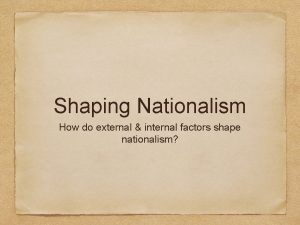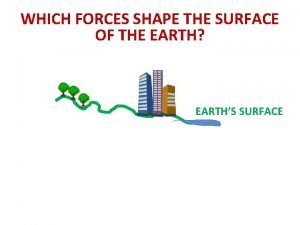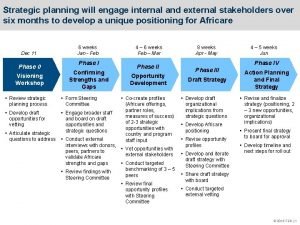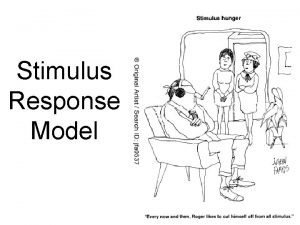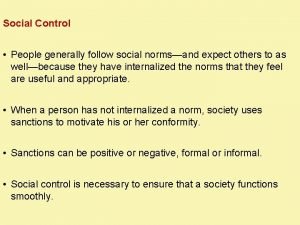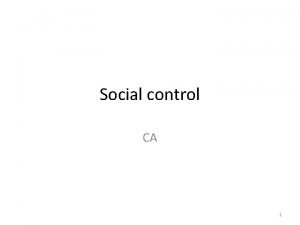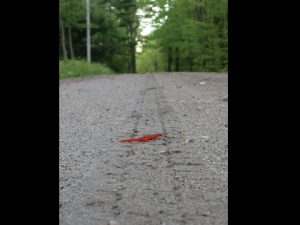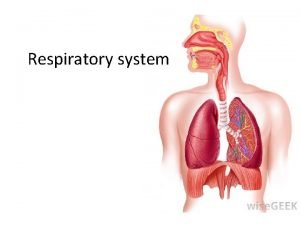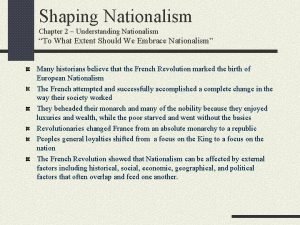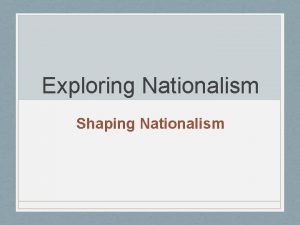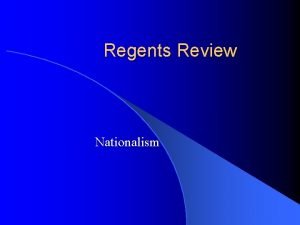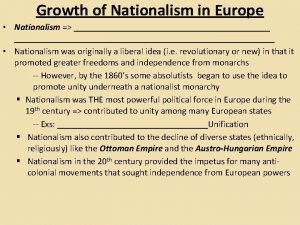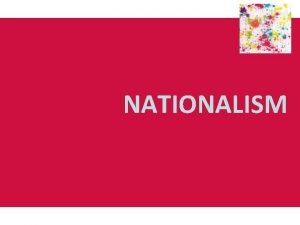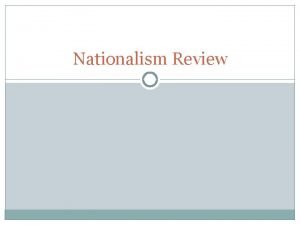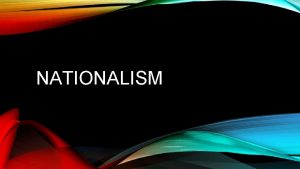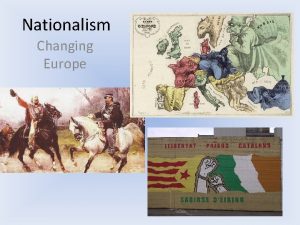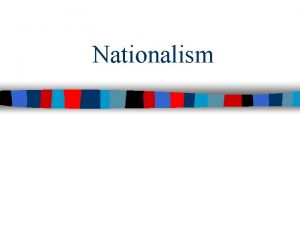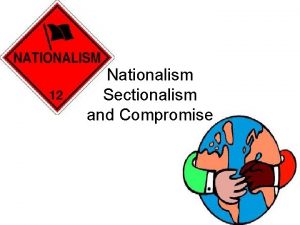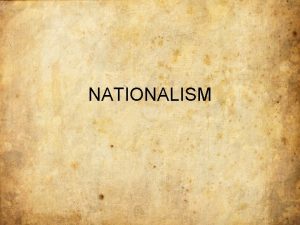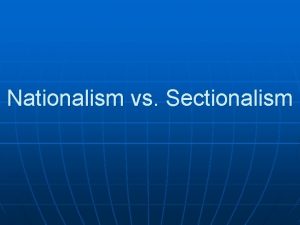Shaping Nationalism How do external internal factors shape



















- Slides: 19

Shaping Nationalism How do external & internal factors shape nationalism?

Who are you, really? https: //www. youtube. com/watch? v=Fw 7 Fh. U-G 1_Q

Remind me…what is nationalism?

How do you express nationalism? Examples


Time for a New National Anthem? https: //www. youtube. com/watch? time_continue=1&v=p. Huzl 5 d. UKVM

The Development of Nationalism is Shaped by: 1. 2. 3. 4. 5. Historical Geographic Political Economic Social FACTORS

French Revolution https: //www. youtube. com/watch? v=l. TTv. Kw. Cyl. FY

Jigsaw Activity: The French Revolution Form groups of 4 Each group is responsible for creating a mind map that: Examines 1/5 factors that helped shape new ideas about the French nation (p. 43 -50) As a collective, we will reconvene and present your understanding — Allocate a speaker

Historical Factors No single event caused the French Revolution. The path to revolution was a long process that unfolded over decades. Still, a single event can often capture a people’s collective imagination and inspire them to take action. In the case of France in 1789, this event was the Storming of the Bastille. The Bastille was a Paris prison where, it was rumoured, the king locked up people who spoke out against him. On July 14, 1789, about 600 angry Parisians successfully attached the Bastille and took control of this symbol of tyranny. This event is usually considered to be the beginning of the French Revolution, and July 14 is now celebrated as a national holiday in France. Textbook and Mr. Lowe

Social Factors Before the French Revolution, France was divided into strict social order that was defined largely by birth. The monarch and aristocrats, who also made up much of the high-ranking clergy in the Catholic Church, held most of the power. In 1789, this ruling elite made up about 4% of France’s total estimated population of 26 million. The remaining 96% were considered common people. The ruling elite paid few taxes, but their power enables them to accumulate great wealth by collecting taxes, rents, and other fees from the common people. Textbook and Mr. Lowe

Economic Factors During the 18 th century, France was almost constantly at war with its traditional rival, Britain, as well as other European countries. These conflicts, which included some support for the rebels in the American War of Independence, were costly - and largely unsuccessful. As a result, the French economy was in chaos by the late 1780 s. The decades of war had drained the treasury, and the country was nearly bankrupt. To raise money, King Louis XVI decided that the people, including French aristocrats, should pay more taxes. Textbook and Mr. Lowe

Geographic Factors At the same time as Louis XVI was demanding that people pay more taxes, large parts of France were suffering severe weather. The winter of 1788 -89 was bitterly cold with piles of snow that blocked roads and made trade and travel impossible. When the snow melted, it caused floods in some areas. Then, in the spring and summer of 1789, parts of the country were hit by drought - a long period of dry weather. These conditions combined to destroy grain crops and create a shortage. As the shortage worsened, the prices of flour rose. As a result, many people could no longer afford to buy bread, which was a staple of their diet. Textbook and Mr. Lowe

Political Factors By late summer 1789, the National Assembly had put the finishing touches not the Declaration of the Rights of Man and of the Citizen. This political action, which abolished the traditional privileges enjoyed by the monarch, the clergy, and the aristocracy, sparked a bloody struggle that eventually led to the creation of a French nation based on new principles. It established France as a secular — non-religious — republic. The 17 articles of the Declaration set out these principles and became the basis of the new French constitution. This document has influenced all subsequent declarations and charters of rights. Textbook and Mr. Lowe

How have People in Canada Responded to some Factors that shape Nationalism?

Canadians and their Myths • One myth that is part of the collective • consciousness on many Canadians is the story of building the Canadian Pacific Railway. John A. Macdonald, Canada’s 1 st prime minister, dreamed of an iron road that would link the country of Canada from coast to coast, the Atlantic to the Pacific Ocean.

Railway & Canadian National Identity • The builders of the CPR faced many challenges; • • • mosquito-infested swamps, Western plains, mountain ranges. Completed in 4 years and 6 months by French, English, Scottish, Irish, Italian, Slavic, Swedish, American, Chinese and Canadian workers. When they completed this great project, they felt as though they had proved something- Canadians could overcome huge obstacles! This view helped to make the CPR a national symbol!

Challenges to Canadian Myths • Early 1900’s, people of British heritage made up the • • dominant cultural groups in Canada. British culture, traditions, and language was dominant. Francophone Canadians (French) and Aboriginal peoples began to tell their stories and histories. As they affirmed their identities they challenged the idea that Canada was British. They also challenged some of the creation of Canada myths.

FNMI & Quebecois Nationalism • Read pages 57 -59 • List one opportunity and one challenge for • • each group in acquiring nationalism. Read Taking Turns on page 59 and respond in paragraph format to the question at the bottom on the page. (10 marks)
 Internal and external factors of nationalism
Internal and external factors of nationalism How do internal and external forces shape the earth
How do internal and external forces shape the earth The supportive stance
The supportive stance External-external trips
External-external trips External forces that shape the earth
External forces that shape the earth Drag divergence mach number
Drag divergence mach number Shape matching and object recognition using shape contexts
Shape matching and object recognition using shape contexts Template matching
Template matching Stimulus plant
Stimulus plant Internal users of accounting
Internal users of accounting Key internal and external stakeholders
Key internal and external stakeholders Internal tangent vs external tangent
Internal tangent vs external tangent Internal vs external stakeholders
Internal vs external stakeholders Stimulus response chart
Stimulus response chart Formal social control
Formal social control Social control mechanisms
Social control mechanisms Salamander internal fertilization
Salamander internal fertilization External respiration process
External respiration process Internal and external reliability
Internal and external reliability External and internal quality control
External and internal quality control
